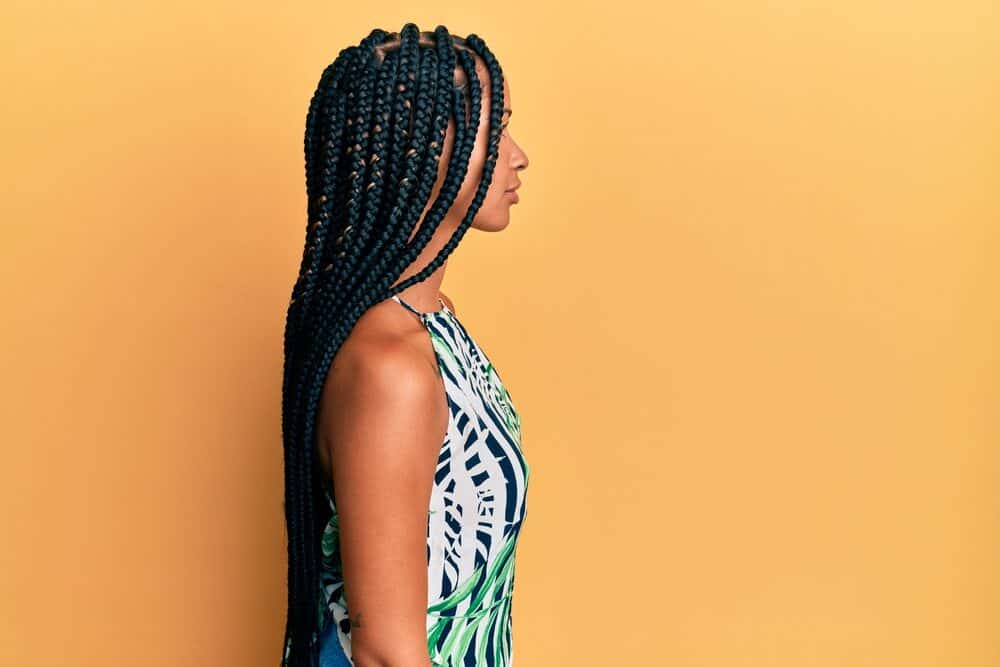
Braids are not only beautiful to look at, but they allow you to tap into the hair growth benefits of protective hairstyling.
Most people can enjoy braids without significant hair and scalp issues, but if you have dandruff, things can get hairy in a hurry. Dandruff is notoriously tough to manage with braids.
But there’s no need to worry. In this article, we will tell you how to get rid of dandruff with braids. We’ll include tips, and tricks you can use before and after braid installs to keep your scalp moisturized, healthy, clean, and irritation-free.
Table of Contents
- 1 How To Get Rid of Dandruff With Braids
- 2 Cleanse Your Scalp
- 3 Dry Your Hair Thoroughly
- 4 Spot Treat with Peppermint Oil or Jojoba Oil
- 5 Use Tea Tree Hair Spray
- 6 Make Sure You Are Getting Enough Nutrients
- 7 Don’t Leave Your Braids in Too Long
- 8 Resist the Urge to Scratch
- 9 Try Not to Overuse Products
- 10 Dandruff Prevention Before Braid Installs

How To Get Rid of Dandruff With Braids
Dandruff is a common scalp condition that can cause white flakes to appear on your hair and clothes. While it's not harmful, dandruff can be embarrassing and unsightly. Luckily, there are several ways to get rid of dandruff using braids.
To get rid of dandruff while wearing braids, you should thoroughly clean your scalp and allow your hair to dry completely. You can also use peppermint oil or jojoba oil to treat any areas where you see flakes.
We also recommend creating a DIY tea tree oil hair spray to help keep your scalp free of dandruff. Food intake is also important. Ensure you are getting enough nutrients in your diet (more details are provided later in the article).
Finally, don't leave the braids in too long. Resist the urge to scratch your scalp, and try not to overuse heavy hair products. These tips will help you get rid of dandruff while wearing braids and mitigate potential issues in the future.
In the next section, we'll discuss these tips in more detail.
Cleanse Your Scalp
You should wash your hair and scalp approximately once per week, even when you are wearing it in a braided style. When you do wash your braids, use a mild shampoo and conditioner.
You can also dilute your products to help ensure that the product is equally distributed on your braids and scalp and effectively removes any build-up.
You should also use an anti-dandruff shampoo on the parts of your hair where you can see dandruff flakes on your scalp or in your braids.
Leave any medicated products like anti-dandruff shampoos in your hair for about 5 minutes instead of rinsing them out immediately.

Dry Your Hair Thoroughly
Properly drying your hair after washing will also help reduce your dandruff symptoms. Leaving your hair wet can cause irritation to the scalp and result in skin inflammation (which can worsen dandruff).
We recommend that you dry your hair for at least 30 minutes with a hooded dryer. If you don’t have access to a hooded dryer, leave your braids out for a full day to air dry.
Make sure you are positive your hair is 100% dry before pulling your braids into a ponytail or covering them up with a scarf or bonnet.

Spot Treat with Peppermint Oil or Jojoba Oil
An oil that is fantastic for spot-treating dandruff is peppermint oil. It’s a tremendous anti-inflammatory and anti-fungal remedy, which helps tremendously to stop and reverse the effects of dandruff.
To give it a try, take the following steps:
- Dilute the peppermint oil with a carrier oil of your choice (olive oil, coconut oil, etc.). Dispense 1 tablespoon of your chosen carrier oil and a few drops of peppermint oil. We recommend using up to 3 drops of peppermint oil.
- Mix the oils together and then load up a q-tip or cotton ball with the resulting hair oil mixture.
- Apply the oil directly to your scalp wherever you experience symptoms of dandruff.
Not only does peppermint oil have medicinal benefits, but it also has a fantastic scent and an invigorating tingling effect. Read this article to learn more about how to keep your hair smelling good all of the time.
Jojoba oil mimics the naturally occurring oil sebum produced by our scalp. It is also full of antioxidants that help keep your scalp healthy. You can apply it straight to your scalp from the container – no dilution is needed.

Use Tea Tree Hair Spray
Topical oil treatments can get messy, and if they’re not your style, maybe a tea tree hair spray will be better suited to you.
One of the most widely used remedies for dandruff with braids is witch hazel and tea tree oil spray. This treatment is a natural anti-inflammatory that’ll help soothe an itchy scalp and heal dandruff.
To mix up your witch hazel and tea tree spray, combine up to 10 drops of tea tree oil, 5 tablespoon of witch hazel, and a teaspoon of a carrier oil of your choice (e.g. coconut oil).
You can apply this mixture in two ways.
The first is by dipping a few cotton balls into the liquid and then applying it to any areas where your scalp is exposed. The second method is to transfer the mix into a spray bottle and spray it onto your scalp.

Make Sure You Are Getting Enough Nutrients
Your scalp health is directly linked to your nutrient intake. Three essential micronutrients proven to increase the health of your scalp and decrease your dandruff symptoms are:
- Zinc
- Protein
- Omega-3 fatty acids
If you are looking for a zinc boost in your diet, try adding spinach and almonds. You can increase your protein intake by consuming more peas, quinoa, and lean meats.
Omega-3 fatty acids come from walnuts and basil. These foods are also great for your overall well-being. If you’re unable to adjust your diet to include more of these nutrients, it may be worth it to look into nutritional supplements.

Don’t Leave Your Braids in Too Long
If you leave your braids in too long, your scalp will accumulate a surplus of sweat, product, and natural oils – this can exacerbate dandruff symptoms.
It’s for this reason that you should take down your braids every 8-10 weeks. With your braids removed, you will have the opportunity to clean up excess build-up and scalp flakes and re-condition your hair and scalp.
Don’t forget to give your hair a 1 to 2 week break in-between braid installations.
Whenever you refresh your braids, you should deep condition and exfoliate your scalp. In doing so, you’ll be able to nip dandruff build-up in the bud and keep your scalp free of any potential residue.
Resist the Urge to Scratch
This step is very simple but incredibly hard to follow. When you have dandruff, your scalp can become very itchy. But it is best to avoid scratching your scalp with nails or a comb. This irritates the skin on your scalp further, increasing the risk of hair loss. It can also make dandruff worse.

Try Not to Overuse Products
Gel, hair spray, and mousse should be used sparingly when you have dandruff. Luckily, when you have braids, you won’t often need to use these products.
However, if you want to try a braided hairstyle that requires gels or other leave-in products, use as little of the product as you can. This will help prevent a build-up of product in your hair which in turn decreases scalp irritation and dandruff complications.
Dandruff Prevention Before Braid Installs
Fighting dandruff starts before you get your hair braided. Here’s an expert tip that you can use pre-install to minimize dandruff symptoms.
If you are prone to dandruff, it is recommended that you exfoliate your scalp 2-3 days BEFORE getting your braids. Exfoliating your scalp helps fight dandruff by removing the excess yeast called Malassezia.
This type of yeast irritates the scalp and causes the cells on your scalp to grow quicker than usual, leading to an itchy, irritated scalp and flaky skin.

You can make an exfoliant at home by mixing equal parts of:
- Hair conditioner
- Brown sugar
- Fine ground oatmeal
Apply the mixture to your wet hair after you shampoo. Gently massage it into your hair using circular motions, and rinse well once you are done.
To start, we suggest mixing 2 tablespoons of each ingredient - this should be enough for a one-time exfoliation treatment.
You can also buy exfoliants from your local drug store, department store, or Amazon. Nioxin Scalp Recovery Purifying Exfoliator is a highly-rated flake remover and soother.
There are many types of store-bought scalp exfoliators on the market, from sulfate-free scrubs to Himalayan sea salt scrubs. Choose yours based on your personal preference.
Note: If your dandruff worsens after getting a braided style, we recommend reaching out to a dermatologist in your area. They will be able to instruct you further on how to remedy it.
- Sea Salt Shampoo for Dandruff
- How To Use Epsom Salt for Dandruff
- Arnica Hair Oil for Dandruff
- How To Use Almond Oil for Hair Dandruff
It is essential for everyone with braids to be attentive to the health of their hair and scalp. But it’s even more important for those with dandruff.
You’ve got to think of, and tend to, your scalp before, during, and after wearing your hair in any braided style. We hope that this article was helpful to you, having given you proven information, techniques, and tips you can use on your braided hair.




